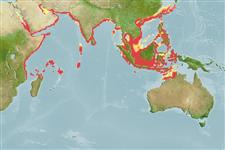Common names from other countries
Environment: milieu / climate zone / depth range / distribution range
Ecologia
Demersal; intervalo de profundidade 3 - 170 m (Ref. 275). Tropical; 30°N - 15°S, 32°E - 131°E (Ref. 275)
Indo-West Pacific: Indian Ocean, Red Sea and Arabian Sea, eastwards from Mozambique to South China Sea and the Philippine Sea, northward to Taiwan.
Length at first maturity / Tamanho / Peso / Idade
Maturity: Lm 10.0, range 9 - 12.9 cm Max length : 40.0 cm ML macho/indeterminado; (Ref. 116232); 23.5 cm ML (female); Peso máx. publicado: 1.5 kg (Ref. 275); Idade máx. registada: 3.00 anos (Ref. 275)
Maximum size for female, 23.5 cm, mantle length from Ref. 116229. Minimum depth from Ref. 104457. Neritic, on shallow waters (Refs. 275, 128042). Feeds on fishes, crustaceans and squids (Refs. 275, 104236). Cannibalism is common (Ref. 275).
Members of the class Cephalopoda are gonochoric. Male and female adults usually die shortly after spawning and brooding, respectively. Mating behavior: Males perform various displays to attract potential females for copulation. During copulation, male grasp the female and inserts the hectocotylus into the female's mantle cavity where fertilization usually occurs. Life cycle: Embryos hatch into planktonic stage and live for some time before they grow larger and take up a benthic existence as adults.
Roper, C.F.E., M.J. Sweeney and C.E. Nauen. 1984. (Ref. 275)
Categoria na Lista Vermelha da IUCN (Ref. 130435)
Categoria CITES (Ref. 108899)
Not Evaluated
Not Evaluated
Utilização humana
Pescarias: espécies comerciais
| FishSource |
Ferramentas
Fontes da internet
Estimates based on models
Preferred temperature
(Ref.
115969): 22.9 - 28.6, mean 27.4 (based on 961 cells).
Resiliência
Elevada, tempo mínimo de duplicação da população menor que 15 meses (K=0.3-2.25; tm=1; tmax=3).
Vulnerabilidade
Low vulnerability (14 of 100).
